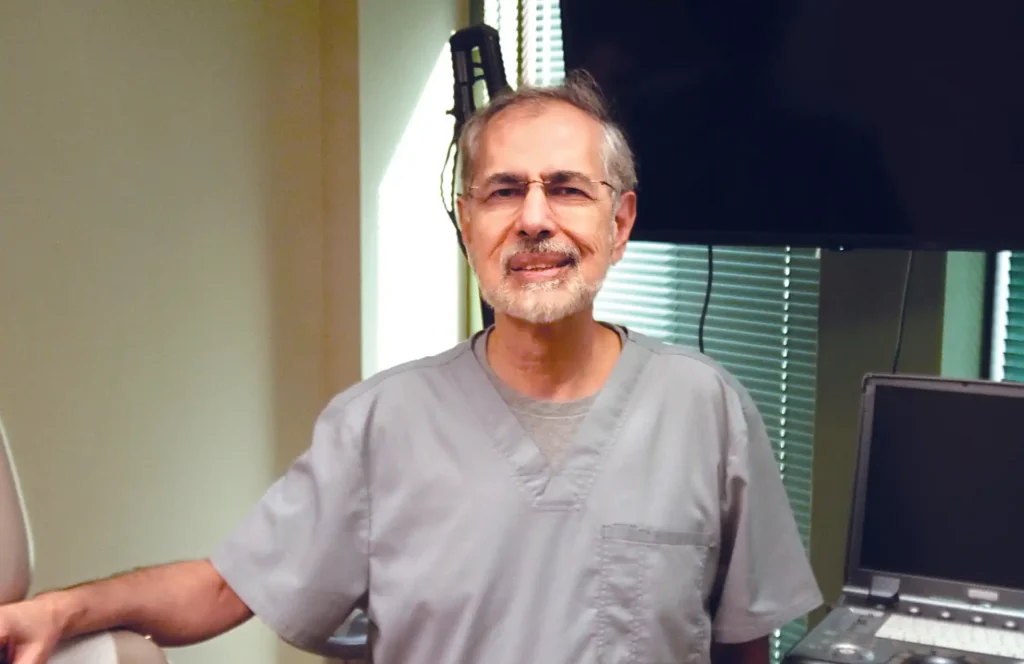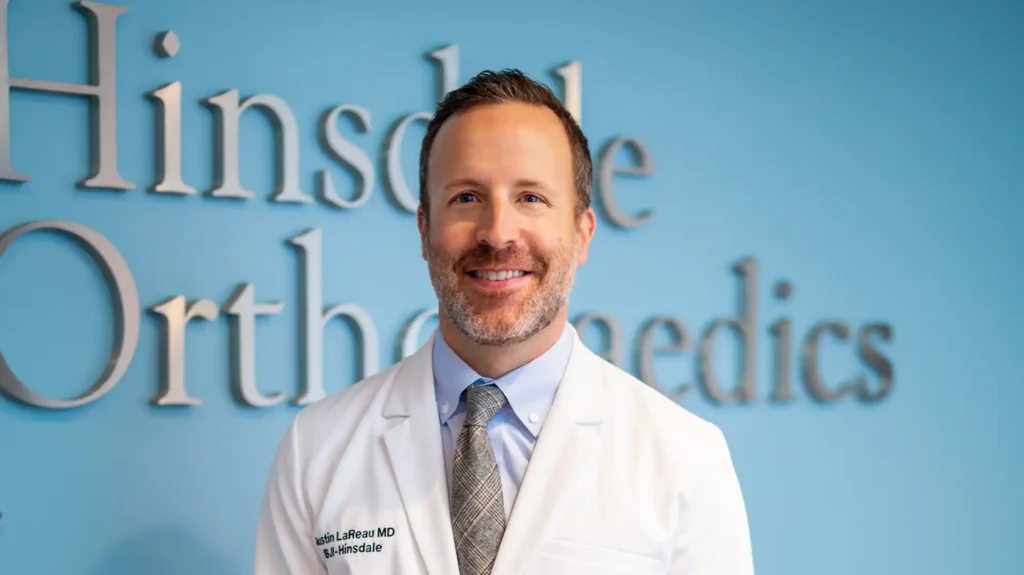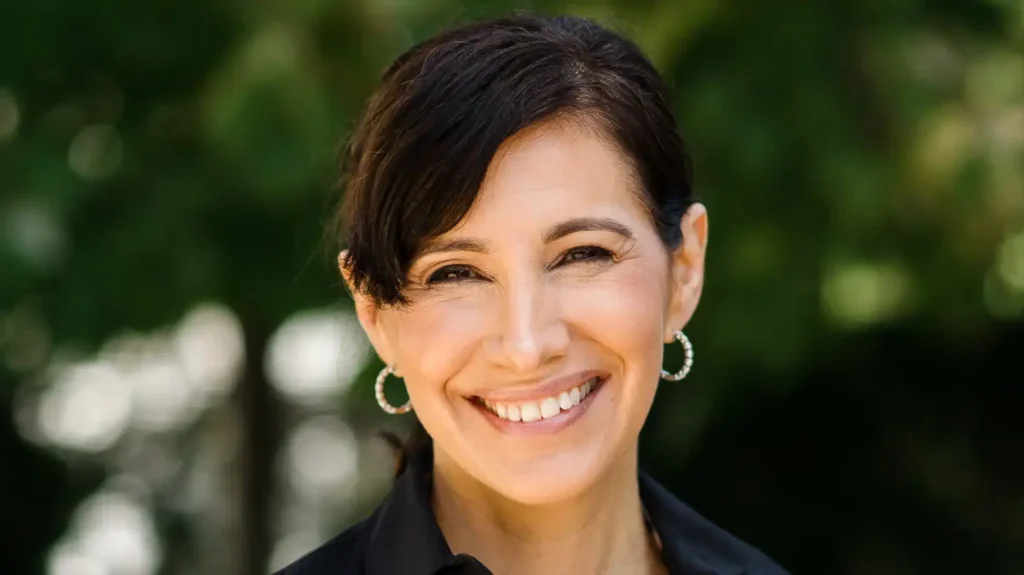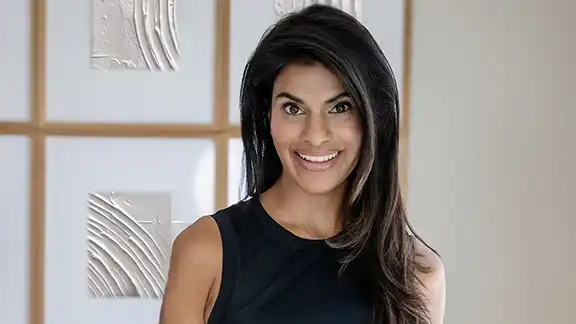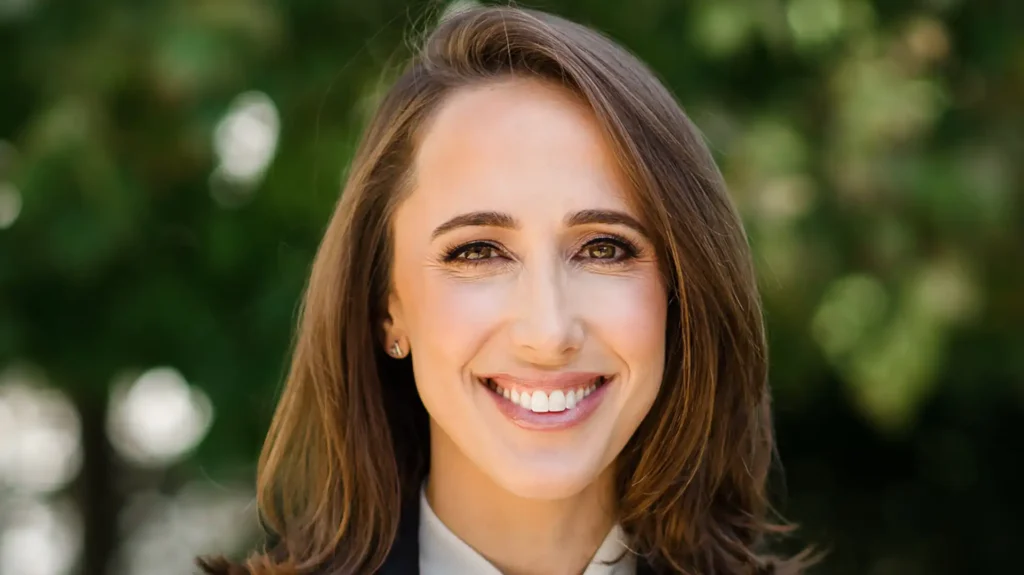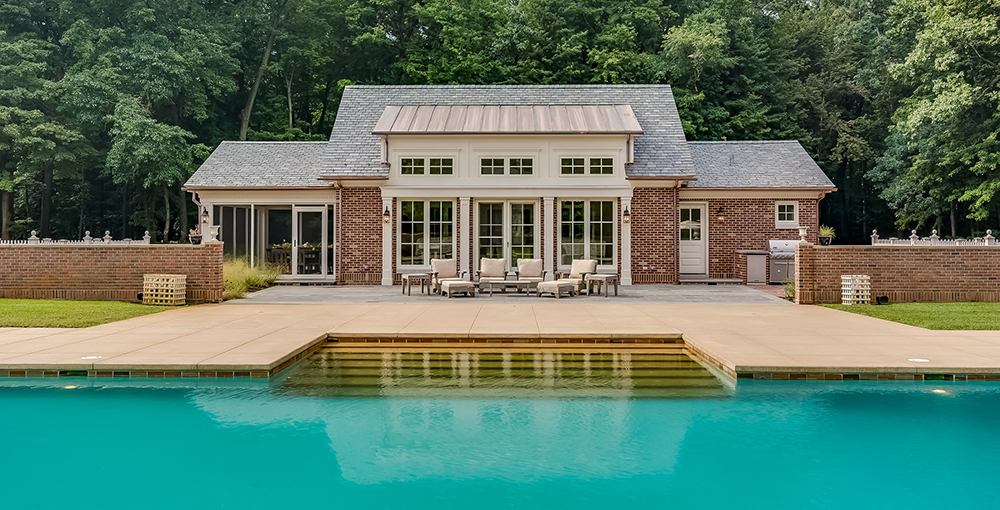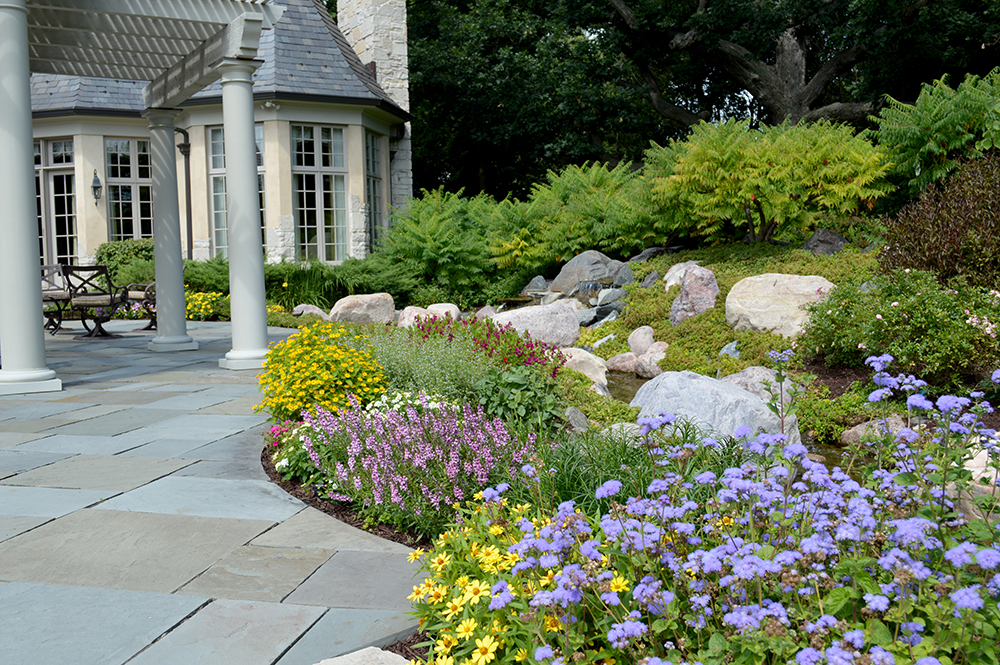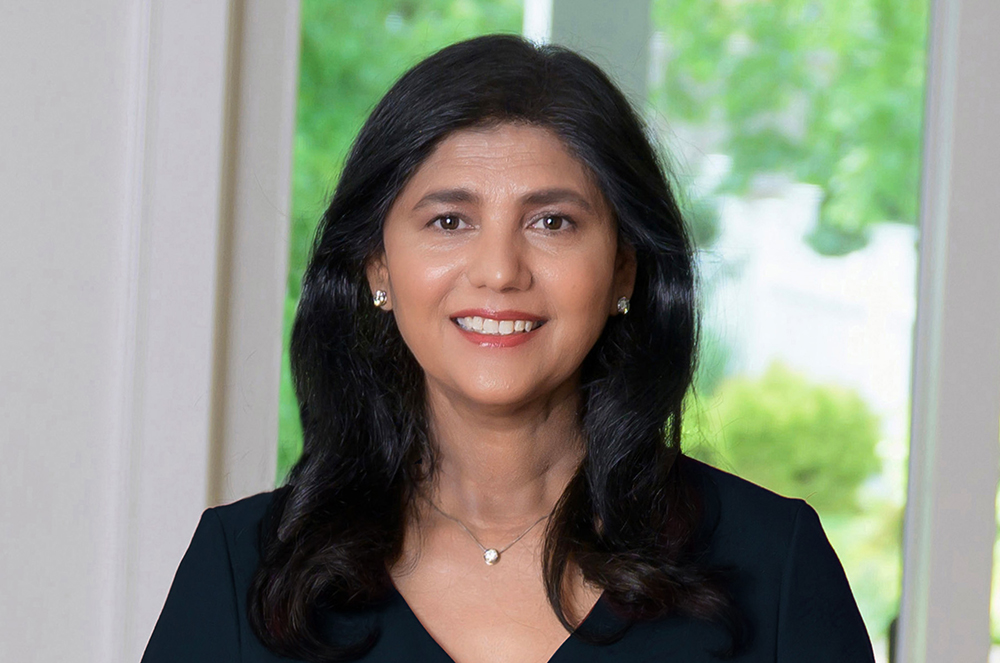
Charlie Hartley, Patriot and Successful Entrepreneur
By Larry Atseff
Tom Brokaw, famous as a national nightly TV news anchor, became even more famous when in 1998, he published interviews and observations about the men and women he called the “The Greatest Generation”—those who grew up during the Great Depression and World War II. One person he didn’t interview was Charlie Hartley—yes, that Charlie Hartley, of Hartley’s Cycle Shoppe in Hinsdale. In these times of a pandemic, which has upset the very basics of living throughout the world, and fanciful notions like “cancel culture” are attempting to literally rewrite history, his factual history is worth knowing.—It is also reassuring. Charlie was born on June 28, 1928 in Elmhurst, one of three children. His father Charles was secretary-treasurer of the Elmhurst Chicago Stone Co., and served in World War I; while his mother was a housekeeper. The family had three children. Even though his father had a good job, Charlie was expected to work at an early age. Three early doses of reality On his first job, he learned a valuable lesson about taking care of customers. He recalls working on a route delivering Saturday Evening Post magazines. He would go door to door, with a sack full of the magazines, which were “unusually tall.” In fact, when it rained, they got soaked. When he started losing customers, he used his common sense and found a magazine that fit into his sack so they didn’t get wet. He implemented another improvement when starting using a bike to make more deliveries. While it expanded his route, when the bike broke down, he had to rely on himself to fix the chain or the flat tire. Little did he know then how handy it would be to know how to repair bikes. A serious dose of reality hit in 1945, when Charlie walked onto one end of the stage at Elmhurst (York) High School to receive his diploma, and went to the other end to meet an army recruiter who enlisted him into military service. Since the war was still raging, he knew it wouldn’t be long before he would be going overseas.
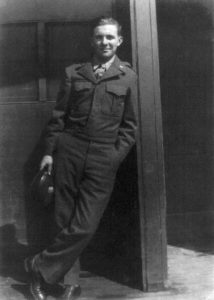
Young Charlie Hartley in uniform during World War II
After four weeks—a standard period of leave—and before basic training, he was sent to Ft. Leonard Wood, Missouri for six weeks, and then on to Ft. Lewis, Wash. for further training as a combat engineer. “While Ft. Leonard Wood was hot and humid, Ft. Lewis was always raining,” Charlie said. “We never saw the sun one day after we got there—never. When I looked out the window next to my bunk, those little squares in the screen were always filled with water in the morning. That’s how humid it was.—And our boots never got dry. You had to change boots every day, but your boots never got dry.” An entrepreneurial spirit Charlie remembers one unique situation, which speaks to the fact that he never has been shy when it comes to making money and seeing opportunities. “While we were at Fort Lewis, they were going to let us come home for Christmas for one week,” he said, “and I asked the captain of our company if I could charter some airplanes to fly the guys home to Chicago. And he says, ‘If you think you can do it, go ahead.’ And I did.” The trips to Chicago and back to Seattle were “trips” in themselves. “I hired two commercial DC-3s,” Charlie said. “We flew the guys home to Chicago. We landed in the northeast corner of Montana to refuel, and it was snowing out. And our plane came in first; [and a] second plane came in. And while he was taxiing over to the fuel depot, the wings hit a hangar, so it decommissioned the aircraft. So, they had to bring another airplane in from wherever it was coming from, and fly those guys home. So they were a day later than we were, but they got back okay to Chicago.
“The World and I, especially, will never forget about one month before the invasion was to take place, an atomic bomb was dropped on hiroshima and then on nagasaki to convince the japanese to surrender.”
“The trip back to Seattle was no picnic either. Of course, they never have snow in Washington, because it always rains. But as we approached Washington, it was snowing. The airport was at the Boeing plant landing-strip that had no capacity for removing snow on the runway. So we had to land at another airport, and on the other side of the mountains at Wenatchee, Wash. And then the airlines had to hire buses to get us over the mountains. Well, when you get up in the mountains, what are you going to have?—more snow. So we followed a snow-plow. This caused 150 guys to be AWOL, because of Seattle having snowfall. That was an experience by itself. I had never followed a snow-plow that a big propeller in front that throws the snow off into the woods—[that] doesn’t push it to the side like they do on our highways here.” Charlie said the plane traveled about 3 miles per hour. At Ft. Lewis, Charlie and his fellow servicemen learned what a combat engineer does: laying down runways and roads, building bridges and operating LSTs (landing ship tanks) in preparation for an invasion of Japan. Like thousands of others, he was shipped out to Okinawa to get ready.
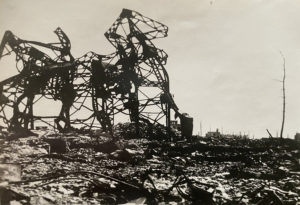
The devastation caused by atomic bomb dropped on Japan
When an international event changed his life
“The world and I, especially, will never forget about one month before the invasion was to take place, an atomic bomb was dropped on Hiroshima and then on Nagasaki to convince the Japanese to surrender—what a dramatic turn,” Charlie said. The Japanese indeed surrendered on Sept. 2, 1945, aboard the USS Missouri. And while many Japanese died because of the bombs, many more were spared on both sides, because it avoided the deaths that would have been caused by the massive allied invasion that was being planned. And just like that, the mission of soldiers in Charlie’s company and thousands of others completely changed from fighting a bloody battle to the new American role of helping Japan to recover from the bombing devastation. “We spent two years working to put Japan back together,” he said. “They had no water, no electricity, no roads, no buildings—it was our job to put all of this back. I remember as we cleaned up the bombed-out streets, bombed-out streetcars and buses, they were all put away in the fields. The Japanese men would actually come during the night, and wheel them away and put them on their property. I don’t know how they did it, but they did, so they could live in them. In reality, all of this belonged to the Japanese anyway. There was nothing standing between Yokohama and Tokyo. The only [things] that [were] left were I-Beams and pieces of chimneys.” “Because we had so many companies, we actually worked 24 hours a day—different shifts, so things could keep moving. Because there was a big shortage of water, we had to repair the system to get that going. We had to get the trains up and running, getting electricity back for the streetcars again. The remaining streetcars were not enough, so I remember riders were actually hanging off the sides of the streetcars to go from point A to point B.
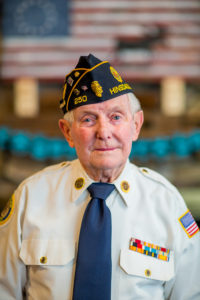
At 92, Charlie Hartley still stays quite active
“Being in headquarters company, I was doing all the battalion’s paperwork. And when the lieutenant colonel was not going to be using his Jeep, he told me I could use [it]. And believe it or not, there were three fellows with me that I graduated with from high school and enlisted with me, and if we had liberty at that time, we’d get the Jeep and go sightseeing. One of the things I wanted to go see was the submarine base that the Japanese had, which was around Tokyo Bay. Those were off-limits, so we never got to see those. “I do remember going to downtown Yokohama. … I bought my mother a set of Mikomoto pearls. And I bought scarves for my sisters, but didn’t buy anything for my dad. … “The same people always ran out of money, because we only got paid once a month. So I always knew ahead of time who the pay officer was, and I would notify him that I’d be at the other end of the table, where I could collect my money. And I lent money to the guys in all the companies, 6 for 5. … If I hadn’t been in headquarters company, I would have never had that opportunity. But when I was there at the pay table, I was able to collect my money. The same guys would come back in the middle of the month and borrow money again. I don’t know what they were doing with their money, but anyhow, it was none of my business as long as they paid me. So I was making money—you might call it investing. “And I gave up smoking cigarettes at that time, too. Because you could sell a carton of cigarettes for 1,500 yen. I have no idea how the translation was. But I’d take my Japanese money to the PX, and the officer would change their Japanese money for American money. Then I’d go to the bank on the post and put it in my account. Yes, I did invest it. I did.” “After two years, we were slated to rotate back to the states—and were we happy!”
A memorable welcome home
“We came on a transport ship, and there was a sign on the Golden Gate Bridge: “Welcome home.” We got in too late in the afternoon to have a tugboat put us into the dock, so we weighed anchor in San Francisco Harbor. And when we got there, the tide changed at that particular time, and just started moving out. We had general prisoners aboard the ship, and they were down in the chain locker (that’s where you put the prisoners—the most secure place of all). They had leg-irons on; they had no handcuffs. They would have to come up to the weather deck, then go down the weather deck, then go down the gangway to get to the galley to eat. Well, these two young men decided that this was their opportunity. So the two of them jumped overboard while they were waiting in line to go down to eat. And of course, as soon as they hit the water, they started yelling for help. The guys in front and back of them didn’t say anything; they just shut up and let them go. When that tide goes out, the tide is really, really strong. It wasn’t long before a man overboard alarm was sounded. And, because it was dark now, they put on the big lights, and got a lifeboat out. And, of course, Alcatraz was off the starboard side. So I don’t know if the operator from our ship had notified them we had two men overboard, but soon they had a motor launch in the water already, and they went over and picked them up. So they got to Alcatraz even before the got off the boat.”
Question and Answer
Larry Atseff: What rank did you have?
Charlie Hartley: I rose to the rank of Tech 5. I received several ribbons and medals for that duty: victory medal south Pacific ribbon, good conduct medal, army of occupation Japan and south Pacific ribbons.
What to do next?
Atseff: There you were, in 1947-8, out of the Army and back to being a civilian. What did you do next?
Hartley: To tell the truth, I was trying to find myself, and I had a lot of different jobs. I came back to Chicago, and got married to Audrey Hauber in 1949. I tried being a milkman; I was a milkman for Bowman Dairy. And we had a bad winter. I had a milk route all the way in Wood Dale, Itasca—way out west. To make sure it wouldn’t be late in the morning, I had an alarm on my radio. It broke, and I took it to Charlie’s, a radio/TV bike repair shop in Oak Park. I asked him to fix my radio/alarm so I wouldn’t get fired for being late. He said, “Okay, if you will help me with repairs.” When he got so many bicycles that it crowded his TV and radio business, I offered to buy the bike repair part of his business and the tools to go with it. I opened a shop in Oak Park, and that was the first time I was actually running a bicycle business. In wintertime, delivering milk was not pleasant. So the spring came, and I said to Audrey, “Let’s go down to Florida.” We put all the bike tools in storage, and went down to St. Petersburg, Fla., where there was a dairy. I went to work for them for a year and a half or two. The split shift was terrible. Because I’d have to go down early in the morning, load the trucks as they pulled up, and then have to come back in when they got done with their route at 1 p.m. I worked until all the trucks got in. You got paid by the hour, but with a split shift, you could never do anything. And so we decided we would come back home to the Chicago area. I went to work for a while at International Harvester and then Chicago Screw and some other places, all the while working with tools and learning my way around machinery, and still working on bikes in off-hours.

Korean Conflict not as eventful as World War II for Charlie
Charlie recalled he was called back to active duty in October 1950.
Hartley: When the Korean War started, I got stationed at Ft. Sheridan, Ill., and I got involved in troop movement. My MOS (military occupation specialty) put me in a headquarters company again. So I actually was attached to the United States Post Office in Ft. Sheridan as a rotation specialist. Everyone in the post office was in troop movement, where we would accompany a group, so we’d rotate these assignments. I would take a train, and then the next five days, I’d be assigned to another train. … Then I’d go to an Airforce base, and try to get a lift home at some airport that’s closer to Chicago, and then I’d take a bus or a train to get back. I’d just drop them off and head back. They always gave you a train ticket to come back on, but you could find ways of getting home faster than a train. And then you could turn your ticket in to get money, which came in handy, because I was married at that time. In all, my service time in both wars was five years, seven months, three days and nine hours.
Atseff: How was the food?
Hartley: I won’t eat hamburger that’s green in the middle. I will not eat dried eggs. The milk was powdered, [which] wasn’t too bad if it was cold, but [when] warm, it was terrible. Dry eggs were terrible, but you ate them, because you were hungry. And I ate the bacon then, because it was something to eat.
Another turn of events and a new direction
Hartley: When I got out of the service this time, I started working for Ford Motor Co. And a situation came up that showed another side of me: standing up for myself. Production was halted one day, because a part for the assembly of an engine wasn’t available, and I was called on the carpet for it. I said I tried to get the part out of engineering so I could have it manufactured. The boss said, “[Whom] did you talk to in engineering?” And I said, “I talked to Mr. A.B.C.” He said, “Get Mr. A.B.C. here immediately.” And they brought him in and asked, “How often has Mr. Hartley been to see you?” And he says, “I don’t really remember how many times. Why?” “Well, the production line is now shut down, because of your inability to produce the engineering needed. Now, are you going to want to pay all those people, while we send them home because you did not get the engineering done?” And Mr. A.B.C. says, “No, I don’t want to do that.” The boss [asked], “How soon can you have the drawings done?” And Mr. A.B.C. [replied], “I can have it in about 12 hours.” The boss said, “I don’t want you going home tonight before you have that done. I want that paperwork down in the main tool room, so it can be manufactured during the night, so we could have the line running tomorrow morning.” I went back to my job out on the production line, and I saw my light on to go see my boss. He said to me, “You never do that.” I said, “Mr. Bowman, what do you mean by that?” He said, “You say ‘them’ or ‘they,’ not the guy’s name.” And I said, “You don’t say you went to Mr. A.B.C.?” ”Never—you never point a finger at anybody, not in the corporation. You’ll never get any place with Ford Motor Co. that way.” When they were closing the plant on 79th [Street] and Cicero Ave., they flew Audrey and I to Detroit, because there was an opportunity to stay with Ford there. And we went over to Flint, Mich., spent the weekend there, looked around the town [and] came back. And Monday morning, the light was on again, so I went in to see Mr. Bowman; and [he] says, “Well, are you going to take the transfer?” I said, “You need an answer now?” And he said, “What’s wrong with that?” I said, “Okay—no.” “What?—you’ve got ten years with the company already. You’re getting a transfer; you get a pay-raise. We’re going to pay for the move. What in the world are you going to do?” I said, “I’m going to open a bicycle and hobby shop.” He said, “You’re going to open a bicycle store?” “Yeah, because I have five kids, and I can get bikes wholesale.” He says, “Now I know you’re nuts.” Now Mr. Bowman was really a nice man, but he was very upset with me about pointing my fingers at the man in engineering. And I said that if they can’t take it, to point a finger at the guy that’s responsible for it—no, I’m not going to go there. And so Audrey and I and the kids moved to Hinsdale in 1954, and we have [lived] in this town for 64 years. (Charlie now resides in Willowbrook with his daughter Debra.)
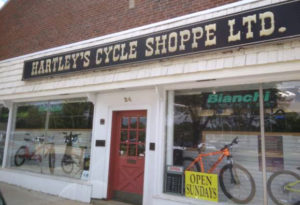
Hartley opened his store on 24 W. Hinsdale Avenue in 1973
Starting to sell bikes in Hinsdale
Hartley: One Saturday morning in 1958, Audrey went to the bakery on west First Street in Hinsdale, and in the window, she saw a sign: “store for rent.” [The] next thing you know, we opened the bicycle store, and Lee Soltwisch was my landlord. I was still working for Ford, and Audrey took care of customers in the store. I would come home and work on the bike repairs at night.
Atseff: Aside from having a bike for each of your five kids, what was your businessplan?
Hartley: Early on, I had occasion to talk with a gentleman by the name of George Bunker, president and owner of Chicago Name and Tag Plate Co. I said I would like a loan of $5,000, so I could build an inventory, and start selling bikes as well as repairing them. He told me to take the loan $1,000 at a time as I needed it, so I wouldn’t have to pay interest on the whole loan at once. And I started out by getting the Schwinn bicycle franchise for the town. At the time, it was at Soukup Hardware, and they weren’t selling too many. I told Schwinn I would buy 20, and they said, “Let’s get started.” I also have the honor of selling the Cushman motor scooter—scooters which required no licenses. That was another good investment in inventory. I just knew those Cushman scooters would sell in a town like Hinsdale, and I always made sure each customer knew what the latest models were, and who was buying them.
I figured if I could get 50 percent of the kids in Hinsdale to buy a bike, 25 percent in Clarendon Hills and 25 percent in Western Springs, we could have enough business. Sales started growing, and I was able to pay my loan back to Mr. Bunker, which helped my credit rating. Then, in 1973, the location at 24 W.Hinsdale [Ave.] opened up, and I purchased the building, and after remodeling, we moved in right before Christmas. Since we were right by the tracks, that location showed train commuters there was a bike shop in town. That helped too. Others in town got to know me and vice versa. For example, for years, me and the folks that run King Keyser would share repairmen. In the winter, they would work for King Keyser on ski equipment; in the summer, they came over to my place to work on bikes. In fact, Rick Johnson at King Keyser respected me so much that he vowed never to open a bike shop while my shop was in business. I always paid attention to customers. When a customer got a ticket for overparking, I said “Let me take care of that for you.” I took a lemon and turned it into lemonade. Charlie got involved with businesses in other ways. He started the West Suburban Bicycle Dealers Association, and served as president for three years.
Getting even more involved in town
In 2010, an event in Charlie’s life recalled his years in the Army, and it changed his life and involvement in the town. Hartley: It was when I went to my son-inlaw’s father’s funeral, and the American Legion did a service for him. And as they came out of the room, I thanked each and every one of them for their dedication to the American Legion and to my son-inlaw’s father. I came back to Hinsdale, and I went up to [village] hall and said, “I’d like to become an American Legion member.” And it’s the best thing I think I’ve done in a long time, because this town of Hinsdale has been so good to me and my family, that anything I can do to help Hinsdale, I’ve got to do. Because raising five children in this town—which is not an easy town to be the underdog in—the Hinsdale people were so good to me, that I just [had] to pay them back. With American Legion Post 250, Charlie has been involved with parades and educational activities to remind young people of the role American servicemen have had in the history of the country. For years, he has also participated in Shriner bike parades, riding a highwheeler bicycle. As another example of community involvement, he helped spearhead the gift of the beautiful clock that graces the Hinsdale train platform as president of the Hinsdale-Clarendon Hills Rotary Club in 2007-08. The bricks at the foot of the clock also have the names of his kids.
The Honor Flight to Washington, D.C.
Of the many forms of recognition that Charlie has earned, perhaps one of the most memorable was the Honor Flight Chicago he took in October 2008 with 162 veterans to Washington, D.C.
Hartley: It was a wonderful experience, down to the last detail. We were greeted at Midway Airport by ‘Andrew sisters’ impersonators, and treated to breakfast by the USO. We landed at Dulles in Washington, and were taken to the World War II memorial and the Korean War memorial. On the way back to Chicago, we heard reveille, the morning wake-up call, and each of us was given an envelope, filled with letters from relatives and friends thanking us for our service. When we landed, there were 600 waiting to greet us. God, it blows you away. In closing our interview, Charlie told the story of when he felt he really arrived in Hinsdale.
Hartley: In 1976, I was convinced by listening to Wally Phillips on WGN to buy a Cadillac El Dorado, the last convertible Cadillac made in the U.S.A. I walked into the dealership with Audrey and said, “I would like to buy that red one with the white seats.” Audrey said that was way too flashy, and instead chose a classy Venetian ivory model. I really enjoyed that car, and still have it to this day…in beautiful condition. As a matter of fact, Charlie has really enjoyed a very good life. He typifies “The Greatest Generation”—people who remind us that hard work, self-reliance, pride of country, proud to serve in the military, practical ideas, willingness to stand up for principles, and an urge to help others is what has made this country great, whether he was in the Army or in his bike store.
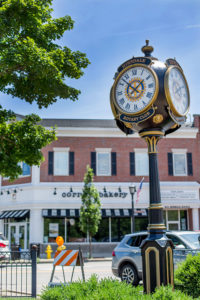
The Hinsdale-Clarendon Hills Rotary Club donated the clock in downtown Hinsdale during Charlie’s club presidency in 2007-08.
In addition to interviewing Charlie directly, we also relied on an interview by Cherryl Walker in 2014 for the Veterans History Project for Library of Congress.
*Original photos provided by Charlie Hartley and photos by Marcello Rodarte



